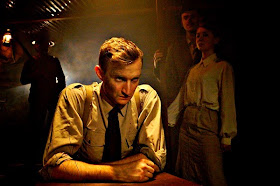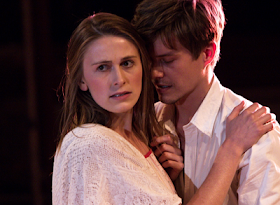 |
| Scott Irwin and Teagan Wouters |
Book: Neil Simon
Music: Marvin Hamlish
Lyrics: Carole Bayer Sager
Presented by HIT Productions.
Queanbeyan Performing Arts Centre until
5th April 2014.
Reviewed by Bill Stephens
This charming
little musical, written by Neil Simon and purportedly based on the real-life
relationship of composer, Marvin Hamlish and lyricist, Carole Bayer Sager,
scored a huge success in Australia in the 1980’s when Jackie Weaver and John
Waters toured endlessly in the original, rather more lavish, Australian
production.
Fond
memories of this production, first seen when Rhonda Burchmore was among the
back-up singers, and later, when it played in the Canberra Playhouse, and Donna Lee was one of the back-up singers, and another later production starring Peta
Toppano and Barry Quin, which also played the Canberra Theatre Centre, and yet
another production, sans backing singers, at the Ensemble Theatre in Sydney
starring Simon Burke and Georgie Parker, were revived by this elegant little
touring production now playing in the Q in Queanbeyan, also minus the backing
singers.
Terence
O’Connell, who both designed and directed this production, has wisely elected
to keep his show firmly grounded in the 1970’s when telephones and dictaphones
were the norm, men wore flairs and women tottered dangerously in sky-scraper
high platform shoes. The show follows the travails of wise-cracking composer, Vernon
Gersch (Scott Irwin) and offbeat lyricist, Sonia Walsk (Teagan Wouters) as they
gingerly negotiate a relationship, both business and personal. There is a third person in this relationship,
Sonia’s ex-boyfriend, Leon, who we never get to meet, but who is hilariously
omnipresent throughout the show.
O’Connell’s uncluttered,
elegant setting and finely detailed direction serve the production well. Scott
Irwin is a delightfully dorky Vernon Gersch. The songs suit his excellent
baritone, and Neil Simons’ rather dated but still chuckle-a-minute dialogue
allows him plenty of opportunity to display his finely honed comedic timing.
Teagan
Wouters is deliciously ditsy as Sonia Walsk, the lyricist with a penchant for
wearing theatre wardrobe left-overs, and plagued with an over-developed
maternal instinct. Together they manage Neil Simons’ script with flair and negotiate
some potentially cheesy moments with panache, developing a convincing onstage
relationship which is both charming and entertaining.
Musical
Director, Alistair Smith, seated inconspicuously at a baby grand piano upstage,
and employing some judicious over-dubs in lieu of the aforementioned backing
singers, provided the musical accompaniments, which on opening night
occasionally threatened to overwhelm the singers.
A special
bonus is the presence of former Canberran, Roni Wilkinson, seen in silhouette
at various moments during the show carrying out her stage-management duties
efficiently and relatively inconspicuously.
It is unlikely that we are ever likely to see a full-scale professional revival of this musical, so for those who have never seen this show, this nicely mounted production by HIT Productions provides a very welcome opportunity to experience it, while providing for the rest of us, a nostalgic reminder of what a delightfully pleasant evening of music theatre it provides.






























